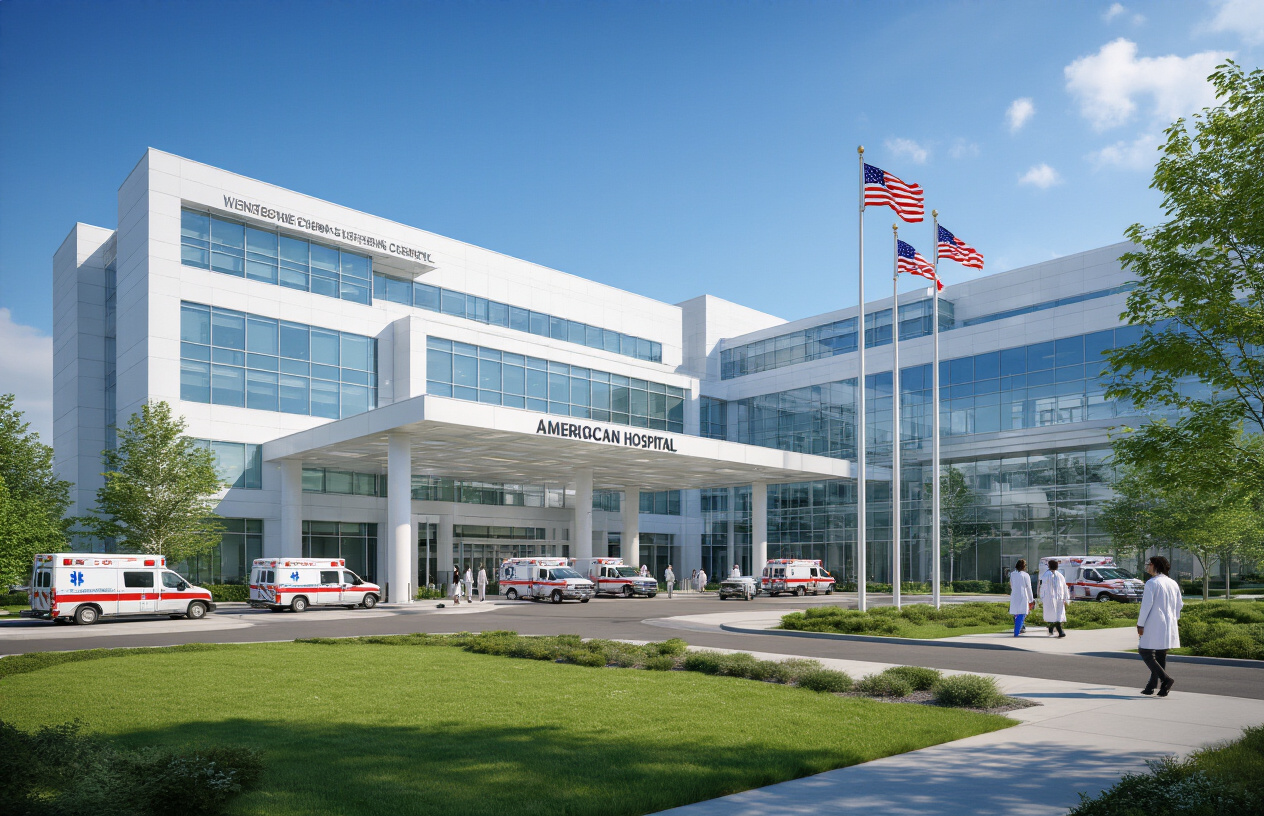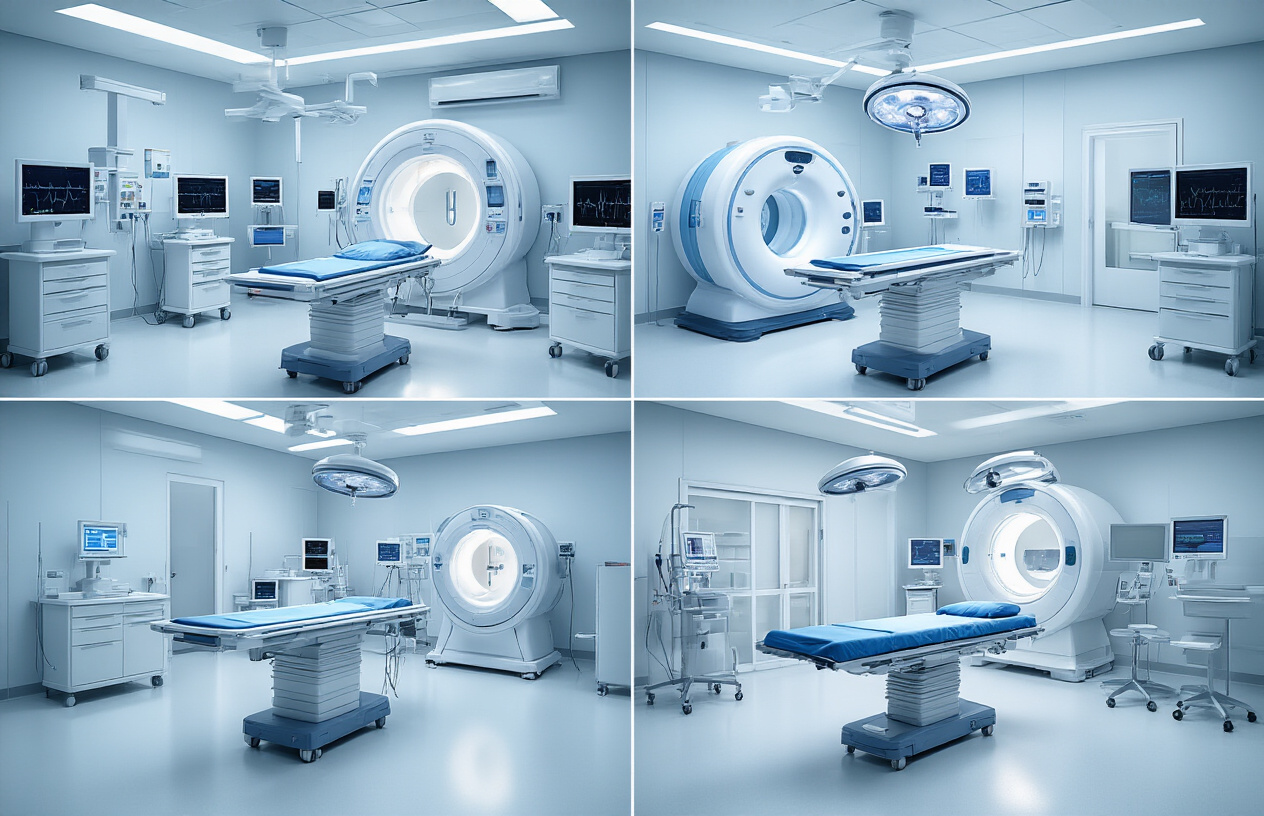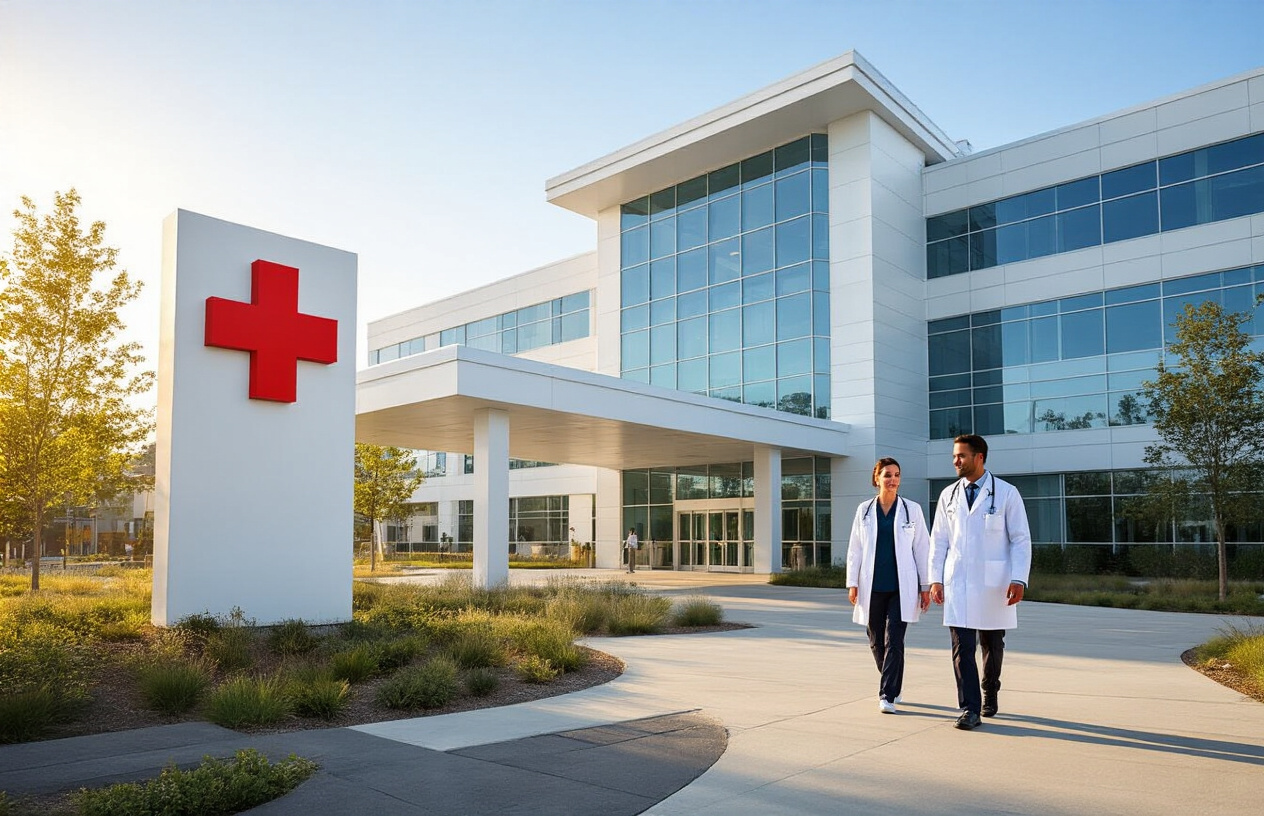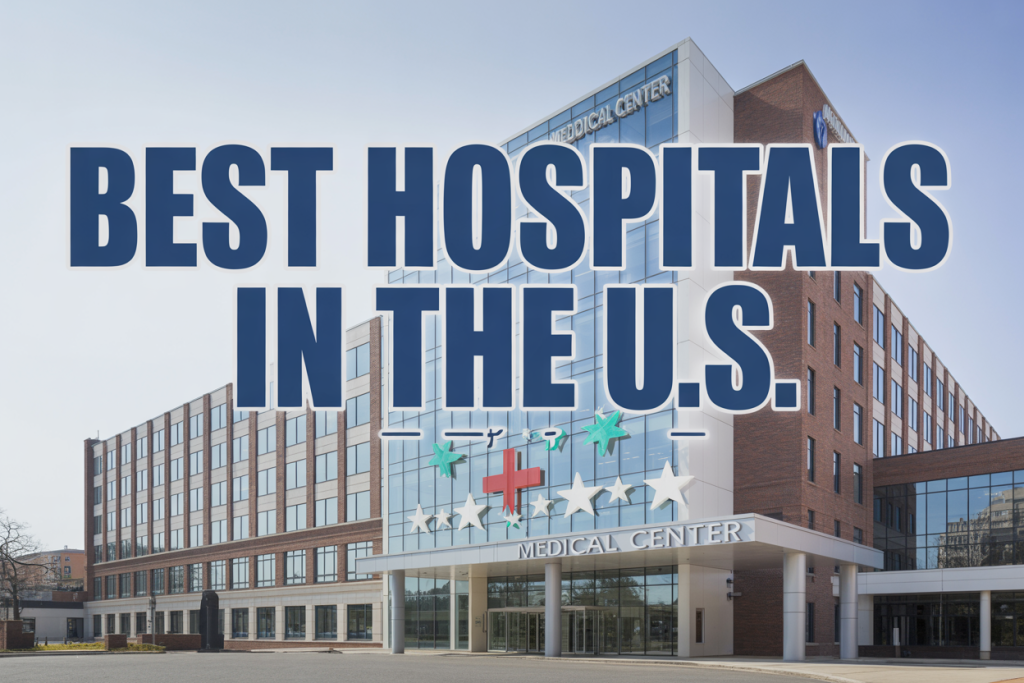Finding the right hospital can feel overwhelming when you’re facing a serious health condition or planning a major procedure. For patients, families, and healthcare advocates, understanding which hospitals consistently deliver top-quality care makes all the difference in your medical journey.
This guide breaks down the best hospitals in the US using trusted ranking systems and real performance data. You’ll discover how major ranking organizations evaluate hospitals, which top-rated medical centers lead in both general and specialty care, and the key factors that separate good hospitals from truly exceptional ones.
We’ll explore the hospital ranking methodology behind trusted systems like U.S. News & World Report, examine patient satisfaction scores and quality ratings that matter most, and show you how to use these rankings to make informed healthcare decisions for yourself and your loved ones.
Understanding Hospital Ranking Systems That Matter Most

U.S. News & World Report methodology and specialty rankings
U.S. News & World Report remains the most recognized authority in hospital rankings 2025, using a comprehensive scoring system that weighs multiple performance metrics. Their evaluation process combines three key components: patient outcomes (37.5%), care-related indicators like nursing ratios and patient safety (30%), and expert opinion from board-certified specialists (32.5%).
The methodology focuses heavily on measurable results rather than reputation alone. For specialty rankings, they analyze condition-specific metrics like survival rates for heart surgery, infection rates in orthopedic procedures, and readmission statistics for various treatments. Each medical specialty receives its own ranking criteria – cancer centers are evaluated on survival rates and case volume, while orthopedic programs are assessed on joint replacement outcomes and patient mobility scores.
Key ranking factors include:
- 30-day survival rates for complex procedures
- Patient safety indicators and infection prevention
- Nurse staffing levels and Magnet hospital status
- Volume of cases handled annually
- Advanced technology and treatment options available
The hospital quality ratings system also incorporates peer nominations from physicians nationwide, asking specialists to identify hospitals they would recommend for the most challenging cases in their field.
Centers for Medicare & Medicaid Services star ratings
CMS star ratings provide a patient-focused perspective on hospital performance rankings, using a straightforward 1-to-5 star system based on quality measures that directly impact patient experience. These ratings draw from Hospital Consumer Assessment scores, clinical care effectiveness, and patient safety data collected from Medicare patients.
The rating system evaluates seven key areas of hospital performance:
- Mortality rates – How often patients die within 30 days of treatment
- Safety of care – Infection rates and surgical complications
- Readmission rates – Whether patients return within 30 days
- Patient experience – Communication with nurses and doctors, hospital cleanliness
- Effectiveness of care – Following best practices for treatment
- Timeliness of care – Emergency department wait times
- Efficient use of medical imaging – Appropriate use of scans and tests
What makes CMS ratings particularly valuable is their focus on patient outcomes rather than hospital prestige. A community hospital might earn five stars while a prestigious academic medical center receives three stars if patient safety indicators and satisfaction scores favor the smaller facility.
Joint Commission accreditation standards
Joint Commission accreditation serves as the gold standard for healthcare institution evaluation, with over 4,000 hospitals nationwide holding this certification. Their rigorous assessment process examines patient care quality, medication management, infection control protocols, and leadership effectiveness through unannounced surveys every three years.
The accreditation process involves comprehensive on-site evaluations where surveyors observe actual patient care, interview staff members, and review medical records. They assess compliance with National Patient Safety Goals, which include preventing patient identification errors, improving communication among caregivers, and reducing healthcare-associated infections.
Critical accreditation areas:
- Patient safety protocols and error prevention systems
- Staff qualifications and ongoing education requirements
- Quality improvement programs and outcome tracking
- Leadership accountability and governance structures
- Emergency preparedness and response capabilities
Hospitals failing to meet standards face conditional accreditation or complete loss of certification, which can impact their ability to receive Medicare and Medicaid payments. Top-rated hospitals typically exceed minimum requirements and demonstrate continuous quality improvement initiatives.
Patient safety indicators and quality measures
Patient safety indicators represent the most critical component in evaluating hospital quality rankings, focusing on preventable complications and adverse events that occur during hospital stays. These metrics include surgical site infections, blood clots after surgery, pressure ulcers, and medication errors – all conditions that reflect the quality of patient care and safety protocols.
Healthcare rankings USA increasingly emphasize transparency in reporting these indicators, with hospitals required to publicly share their performance data. The Hospital Safety Grade from The Leapfrog Group assigns letter grades based on error rates, infection prevention, and safety practices, while the Agency for Healthcare Research and Quality tracks 18 specific patient safety indicators.
Quality measures extend beyond safety to include clinical effectiveness indicators like heart attack treatment protocols, pneumonia care standards, and surgical infection prevention practices. These performance metrics in healthcare help patients identify facilities with consistently better outcomes and lower complication rates across various medical conditions and procedures.
Top-Ranked General Hospitals Across America

Mayo Clinic System Locations and Specialties
The Mayo Clinic stands as one of America’s most prestigious healthcare institutions, consistently earning top positions in hospital rankings 2025. This integrated health system operates three major campuses across Minnesota, Arizona, and Florida, each offering world-class medical care that attracts patients from around the globe.
The flagship Rochester, Minnesota campus serves as the system’s crown jewel, housing over 1,300 physicians and researchers who specialize in virtually every medical field imaginable. This location excels particularly in complex surgical procedures, rare disease diagnosis, and cutting-edge cancer treatment. The Phoenix/Scottsdale, Arizona campus focuses heavily on transplant services, neurology, and orthopedics, while the Jacksonville, Florida location has built exceptional programs in oncology, cardiology, and neurosurgery.
What sets Mayo Clinic apart in US hospital ratings is their team-based approach to patient care. Rather than seeing multiple specialists separately, patients work with integrated care teams that collaborate in real-time. This model has revolutionized how complex medical conditions are treated and has become a benchmark for other top hospitals in America.
The Mayo Clinic’s specialty programs consistently rank among the best hospitals by specialty nationwide. Their cancer program offers some of the most advanced treatments available, including proton beam therapy and personalized medicine approaches. The neurology and neurosurgery departments handle the most challenging brain and spinal conditions, while their cardiovascular program performs thousands of complex heart procedures annually.
Cleveland Clinic’s Reputation for Cardiac Care
Cleveland Clinic has earned its place among the best hospitals in the US primarily through its unparalleled cardiovascular program. For over two decades, this Ohio-based institution has maintained its position as the nation’s top heart hospital, setting standards that other leading hospitals in the United States strive to match.
The hospital’s cardiac expertise spans the entire spectrum of heart and vascular conditions. From routine procedures to the most complex heart transplants, Cleveland Clinic’s cardiovascular team handles over 40,000 procedures annually. Their innovative approaches include minimally invasive cardiac surgeries, advanced imaging techniques, and groundbreaking research in artificial heart technology.
Cleveland Clinic’s success in hospital performance rankings stems from their comprehensive cardiovascular network. The main campus in Cleveland houses the Miller Family Heart, Vascular & Thoracic Institute, which features dedicated units for every aspect of cardiac care. Patients can access everything from preventive cardiology to emergency cardiac surgery under one roof.
The institution’s research excellence in cardiovascular medicine has led to numerous breakthrough treatments now used worldwide. Their physicians pioneered many cardiac catheterization techniques and continue developing new approaches to treating heart disease. This research-driven culture ensures patients receive the most advanced cardiac care available.
Beyond heart care, Cleveland Clinic has expanded its reputation to other specialties while maintaining its cardiovascular leadership. The hospital consistently ranks among the top-rated hospitals for neurology, gastroenterology, and orthopedics, making it a comprehensive medical destination for complex conditions.
Johns Hopkins Hospital’s Research Excellence
Johns Hopkins Hospital represents the gold standard for research-driven healthcare in America. This Baltimore-based institution has maintained its position among the best healthcare institutions USA for over a century, largely due to its seamless integration of patient care, medical education, and groundbreaking research.
The hospital’s research enterprise encompasses virtually every medical specialty, with particular strength in oncology, neurosciences, and pediatrics. Johns Hopkins researchers consistently secure the largest federal research funding among all US hospitals, translating scientific discoveries directly into patient treatments. This research-to-bedside approach means patients often access experimental therapies years before they become widely available.
Johns Hopkins’ cancer program exemplifies this research excellence. The Sidney Kimmel Comprehensive Cancer Center conducts hundreds of clinical trials simultaneously, offering patients access to cutting-edge immunotherapies, precision medicine approaches, and innovative surgical techniques. Many cancer treatments now considered standard worldwide originated from research conducted at Johns Hopkins.
The neuroscience programs at Johns Hopkins consistently rank among the best hospitals for complex care. The hospital’s neurosurgeons perform some of the most challenging brain and spinal procedures, often pioneering new techniques that other medical centers later adopt. Their work in treating brain tumors, epilepsy, and movement disorders has established benchmarks for neurological care globally.
Patient satisfaction scores at Johns Hopkins reflect their commitment to combining research excellence with compassionate care. The hospital’s teaching mission ensures that every patient benefits from the latest medical knowledge, as resident physicians and fellows work alongside experienced faculty members who are often international experts in their fields.
The hospital’s reputation extends beyond individual specialties to encompass a culture of innovation that permeates every department. From developing new diagnostic techniques to creating more effective treatment protocols, Johns Hopkins continues shaping the future of American healthcare while providing exceptional patient care today.
Leading Specialty Care Centers by Medical Field

Best cancer treatment hospitals nationwide
Cancer care demands the most advanced treatments and specialized expertise available. The top cancer treatment hospitals in the US combine cutting-edge research with compassionate patient care, making them essential destinations for complex oncology cases.
MD Anderson Cancer Center in Houston consistently ranks as the nation’s premier cancer hospital. Their multidisciplinary approach brings together specialists from different fields to create personalized treatment plans. The center excels in both common and rare cancer types, with groundbreaking immunotherapy and precision medicine programs.
Memorial Sloan Kettering Cancer Center in New York stands out for its research-driven approach to cancer treatment. The hospital pioneered many current cancer therapies and maintains one of the most comprehensive clinical trial programs in the country. Their patient outcomes for difficult-to-treat cancers often exceed national averages by significant margins.
Mayo Clinic’s Rochester campus offers exceptional cancer care with seamless coordination between specialists. Patients receive comprehensive evaluations within days rather than weeks, and the integrated care model ensures no detail gets overlooked. Their proton beam therapy program represents one of the most advanced radiation treatment options available.
Johns Hopkins Hospital in Baltimore combines world-renowned research capabilities with innovative treatment protocols. The Sidney Kimmel Comprehensive Cancer Center leads in developing new therapies, particularly for brain tumors, pancreatic cancer, and blood cancers.
Premier cardiac surgery and heart care facilities
Heart conditions require immediate access to expert care and advanced surgical techniques. The best heart hospitals in the US maintain cardiac surgery programs that handle the most complex cases while achieving exceptional patient outcomes.
Cleveland Clinic’s heart program consistently ranks number one nationally, performing more cardiac procedures than any other hospital system. Their expertise spans from routine interventions to complex heart transplants and artificial heart implantations. The clinic’s integrated approach connects cardiologists, cardiac surgeons, and rehabilitation specialists under one roof.
Mayo Clinic Rochester’s cardiovascular program excels in treating rare and complex heart conditions. Their multidisciplinary heart teams develop innovative surgical approaches and maintain some of the lowest complication rates in the country. The hospital’s experience with pediatric cardiac surgery makes them a top choice for congenital heart defects.
NewYork-Presbyterian Hospital combines the expertise of Columbia and Weill Cornell medical schools, creating one of the most comprehensive cardiac programs available. Their transcatheter aortic valve replacement (TAVR) program leads the nation in minimally invasive heart procedures.
Cedars-Sinai Medical Center in Los Angeles operates a world-class heart institute with particular strength in complex coronary interventions and heart failure treatments. Their cardiac rehabilitation program helps patients achieve optimal recovery outcomes.
Top-rated children’s hospitals and pediatric care
Pediatric care requires specialized facilities designed specifically for children’s unique medical needs. The best children’s hospitals combine advanced medical technology with child-friendly environments that support both patients and families.
Boston Children’s Hospital leads pediatric care across virtually every specialty, from routine checkups to complex surgical procedures. The hospital performs more pediatric surgeries than any other facility and maintains research programs that advance children’s medicine worldwide. Their neonatal intensive care unit handles the most critical cases with remarkable success rates.
Children’s Hospital of Philadelphia (CHOP) pioneered numerous pediatric treatments and surgical techniques still used today. The hospital’s expertise in pediatric heart surgery, cancer treatment, and rare genetic disorders makes them a destination for families worldwide. Their Center for Fetal Diagnosis and Treatment performs life-saving surgeries before birth.
Cincinnati Children’s Hospital Medical Center combines exceptional patient care with leading pediatric research. The hospital ranks among the top performers in multiple pediatric specialties and maintains one of the most comprehensive pediatric residency training programs in the country.
Texas Children’s Hospital in Houston operates the largest pediatric hospital in the United States. Their specialized programs cover everything from common childhood illnesses to complex conditions requiring multidisciplinary teams. The hospital’s pediatric heart center performs more congenital heart surgeries than any other facility.
Excellence in orthopedics and joint replacement
Orthopedic excellence requires combining surgical skill with rehabilitation expertise to restore patients’ mobility and quality of life. The top orthopedic hospitals specialize in everything from sports injuries to complex joint replacements and spinal surgeries.
Hospital for Special Surgery (HSS) in New York focuses exclusively on orthopedics, rheumatology, and related conditions. This specialization allows them to achieve exceptional outcomes in joint replacement surgeries, with infection rates well below national averages. Their sports medicine program treats professional athletes and weekend warriors with equal expertise.
Mayo Clinic Rochester’s orthopedic department handles complex cases that other hospitals cannot manage. Their integrated approach connects orthopedic surgeons with pain management specialists, physical therapists, and rehabilitation experts. The hospital’s experience with revision surgeries makes them a top choice for complicated cases.
Johns Hopkins Hospital operates one of the most respected spine surgery programs in the country. Their neurosurgeons and orthopedic spine specialists collaborate on complex spinal deformity cases and pioneering minimally invasive techniques.
Cleveland Clinic’s orthopedic program excels in both routine joint replacements and complex reconstructive surgeries. Their same-day joint replacement program allows many patients to go home the day of surgery, reducing recovery time and complications.
Renowned neurology and brain surgery centers
Neurological conditions affect the most vital aspects of human function, making expert care absolutely critical. The best neurology and neurosurgery centers combine advanced diagnostic capabilities with surgical precision to treat conditions affecting the brain, spine, and nervous system.
Johns Hopkins Hospital’s neurology department leads the world in treating complex brain conditions. Their neurosurgeons perform more brain tumor surgeries than almost any other hospital, with outcomes that consistently exceed national benchmarks. The hospital’s epilepsy center offers advanced treatments including brain stimulation therapies.
Mayo Clinic Rochester operates comprehensive neurology and neurosurgery programs that handle rare and complex conditions. Their movement disorder specialists provide advanced treatments for Parkinson’s disease and essential tremor, including deep brain stimulation procedures. The integrated care model ensures patients receive coordinated treatment from multiple specialists.
Massachusetts General Hospital’s neurology department combines cutting-edge research with exceptional patient care. Their stroke center maintains certification as a comprehensive stroke center, providing 24/7 access to advanced stroke treatments that can prevent permanent disability.
UCSF Medical Center in San Francisco leads in treating brain tumors and complex neurological conditions. Their neurosurgeons pioneered awake brain surgery techniques that preserve critical brain functions while removing tumors. The hospital’s multiple sclerosis program offers access to the latest disease-modifying therapies.
Regional Hospital Leaders Worth Considering

Northeast Corridor’s Highest-Rated Medical Centers
The Northeast corridor stands as the epicenter of American medical excellence, housing some of the nation’s most prestigious healthcare institutions. Massachusetts General Hospital in Boston continues to dominate hospital rankings 2025, maintaining its position as one of the top hospitals in America across multiple specialties. This Harvard-affiliated institution excels particularly in cancer treatment, neurology, and cardiac care, earning consistently high patient satisfaction scores.
Johns Hopkins Hospital in Baltimore remains a powerhouse in medical innovation and research. Known worldwide for its surgical expertise and groundbreaking treatments, Hopkins leads in oncology, neurosurgery, and pediatric care. The hospital’s reputation extends far beyond regional boundaries, attracting patients from across the globe seeking complex care solutions.
NewYork-Presbyterian Hospital serves as the Northeast’s largest academic medical center, combining the expertise of Weill Cornell Medicine and Columbia University. This top-rated hospital excels in cardiology, psychiatry, and emergency medicine, while maintaining exceptional hospital quality ratings across all service lines.
Cleveland Clinic has expanded its Northeast presence significantly, bringing its renowned cardiac care and innovative treatment protocols to the region. Their integrated care model and focus on patient outcomes have earned them recognition among the best healthcare institutions USA wide.
Southern States’ Premier Healthcare Institutions
The South has emerged as a major force in American healthcare, with several institutions earning spots among the leading hospitals in the United States. MD Anderson Cancer Center in Houston stands unrivaled as the nation’s premier cancer treatment facility. This specialized institution consistently ranks first in oncology, offering cutting-edge immunotherapy, precision medicine, and comprehensive cancer care programs.
Mayo Clinic in Jacksonville represents the organization’s southern flagship, bringing world-class expertise to Florida. Known for its collaborative approach to patient care and diagnostic excellence, Mayo Clinic Jacksonville excels in gastroenterology, endocrinology, and neurology services.
Duke University Hospital in North Carolina has built a stellar reputation for cardiac care, organ transplantation, and medical research. This top-performing hospital system integrates clinical excellence with groundbreaking research, making it a leader in translating scientific discoveries into patient treatments.
Emory University Hospital in Atlanta serves as the South’s premier academic medical center, excelling in infectious disease treatment, cardiology, and emergency medicine. The hospital’s affiliation with the CDC has positioned it as a national leader in public health and disease management.
Midwest’s Top-Performing Hospital Systems
The Midwest houses some of America’s most respected healthcare institutions, combining traditional medical excellence with innovative care delivery models. Mayo Clinic in Rochester, Minnesota, remains the gold standard for comprehensive medical care. This best hospital for complex care consistently tops national rankings through its team-based approach, where specialists collaborate seamlessly to provide personalized treatment plans.
Cleveland Clinic in Ohio has revolutionized cardiac care and continues to lead in heart surgery, neurology, and urology. Their emphasis on preventive care and wellness programs has earned them recognition for both clinical outcomes and patient experience scores.
Northwestern Memorial Hospital in Chicago excels in multiple specialties, including cardiology, oncology, and orthopedics. This top-rated hospital has become a regional referral center for complex cases, drawing patients from across the Midwest for specialized treatments.
University of Michigan Hospitals in Ann Arbor combines academic excellence with clinical innovation. Known for their research contributions and teaching programs, they excel in transplant medicine, pediatrics, and surgical subspecialties.
West Coast Excellence in Medical Innovation
The West Coast leads American healthcare in technology integration and innovative treatment approaches. UCSF Medical Center in San Francisco stands at the forefront of medical research and patient care, consistently ranking among the best hospitals by specialty in neurology, oncology, and psychiatrics. Their commitment to precision medicine and personalized treatment protocols has earned them recognition as a leader in medical innovation.
Cedars-Sinai Medical Center in Los Angeles combines Hollywood glamour with world-class medical expertise. This hospital excels in cardiac care, oncology, and gastroenterology, while maintaining some of the highest patient satisfaction scores on the West Coast.
Seattle Children’s Hospital has earned national recognition as one of the premier pediatric institutions, excelling in complex childhood conditions and innovative surgical techniques. Their research contributions have transformed pediatric medicine nationwide.
Stanford Health Care leverages Silicon Valley innovation to deliver cutting-edge medical treatments. Known for their work in precision medicine, robotic surgery, and digital health initiatives, Stanford represents the future of American healthcare delivery.
These regional leaders demonstrate that hospital performance rankings extend far beyond traditional East Coast institutions, with excellence distributed throughout the country’s diverse healthcare landscape.
Key Factors That Determine Hospital Quality Rankings

Patient Outcomes and Survival Rates
When evaluating hospital quality ratings, patient outcomes serve as the most telling indicator of a healthcare institution’s true performance. These metrics reveal how well hospitals actually perform when lives hang in the balance, making them central to hospital rankings 2025.
Mortality rates paint the clearest picture of hospital excellence. The best hospitals consistently demonstrate lower-than-expected death rates across various conditions, from heart attacks to complex surgical procedures. These performance metrics in healthcare are risk-adjusted, meaning they account for patient age, severity of illness, and other factors that could skew results.
Readmission rates tell another crucial story. Top-performing hospitals keep patients from bouncing back within 30 days of discharge, indicating comprehensive care and proper discharge planning. The best healthcare institutions USA typically maintain readmission rates well below national averages across multiple conditions.
Recovery time metrics also factor heavily into rankings. Hospitals that help patients return to normal activities faster demonstrate superior clinical protocols and care coordination. This includes everything from post-surgical recovery periods to rehabilitation success rates for stroke and cardiac patients.
Complication rates during treatment provide additional insight into hospital quality. Leading medical centers maintain exceptionally low rates of preventable complications like surgical site infections, medication errors, and procedural mishaps. These hospital performance rankings directly reflect the institution’s commitment to clinical excellence.
Safety Records and Infection Prevention
Patient safety forms the bedrock of top hospitals in America, with infection prevention standing as a primary battleground where excellence gets measured. Hospital-acquired infections remain one of the most preventable yet dangerous aspects of healthcare delivery.
Central line-associated bloodstream infections (CLABSI) rates serve as key indicators. The top-rated hospitals maintain near-zero infection rates through rigorous protocols, advanced training, and constant monitoring. These institutions invest heavily in infection prevention teams and cutting-edge sterilization technologies.
Surgical site infection rates reveal how well hospitals manage one of their most vulnerable patient populations. Leading hospitals in the United States implement comprehensive pre-operative protocols, maintain sterile environments, and follow evidence-based post-surgical care practices that dramatically reduce infection risks.
Catheter-associated urinary tract infections (CAUTI) represent another critical safety metric. Hospitals earning top rankings demonstrate exceptional catheter management, including proper insertion techniques, maintenance protocols, and early removal strategies that minimize infection opportunities.
Hand hygiene compliance rates, while seemingly basic, remain fundamental to hospital safety records. The most successful institutions achieve compliance rates above 95% through comprehensive staff training, monitoring systems, and cultural accountability measures that make safety everyone’s responsibility.
Fall prevention programs also impact safety rankings significantly. Best hospitals by specialty implement multi-faceted approaches including risk assessments, environmental modifications, and staff education that result in measurably lower patient fall rates.
Nurse-to-Patient Ratios and Staffing Levels
Staffing patterns directly influence every aspect of patient care, making nurse-to-patient ratios a critical component of hospital ranking methodology 2025. Research consistently shows that adequate staffing saves lives and improves patient experiences across all care settings.
Registered nurse staffing hours per patient day serve as the gold standard metric. Best medical centers USA typically maintain higher RN hours than their competitors, ensuring patients receive more frequent assessments, faster response times, and better overall monitoring.
Specialized unit staffing requirements vary dramatically. Intensive care units in top-ranking hospitals maintain 1:1 or 1:2 nurse-to-patient ratios, while medical-surgical units typically achieve 1:4 ratios compared to national averages that often reach 1:6 or higher in lower-performing facilities.
Nursing education levels also factor into quality equations. Hospitals with higher percentages of bachelor’s-prepared nurses consistently demonstrate better patient outcomes. The highest-rated hospitals for patient care actively recruit BSN-prepared nurses and support ongoing education initiatives.
Staff turnover rates indicate institutional health and care continuity. High-performing hospitals maintain lower turnover through competitive compensation, supportive work environments, and professional development opportunities that retain experienced staff members.
Float pool utilization and agency nurse dependency reveal staffing stability. The most successful hospitals minimize reliance on temporary staffing through strategic workforce planning, competitive retention strategies, and flexible scheduling options that reduce burnout while maintaining coverage.
How to Use Hospital Rankings for Your Healthcare Decisions

Matching rankings to your specific medical needs
Rankings aren’t one-size-fits-all when it comes to your health. The best hospitals in the US excel in different areas, so you need to dig deeper than overall scores. If you’re dealing with heart issues, Mayo Clinic’s cardiology program might be perfect, but their orthopedic department may not rank as highly for your knee replacement.
Start by identifying your specific condition or procedure. Hospital rankings 2025 show dramatic differences between specialties within the same institution. Cleveland Clinic dominates heart care but Johns Hopkins leads in certain cancer treatments. Look for hospitals that specifically rank high in your medical area rather than just overall reputation.
Consider the complexity of your case too. Top-rated hospitals for patient care often shine with routine procedures, but you might need a specialized academic medical center for rare conditions. Teaching hospitals frequently handle the most challenging cases and have access to cutting-edge treatments that smaller facilities can’t offer.
Insurance coverage and network considerations
Your insurance network can make or break your access to top hospitals in America. Even if a facility ranks number one for your condition, it won’t help if your coverage doesn’t include them or leaves you with crushing bills.
Check your insurance provider’s online directory and call to confirm coverage before making appointments. Some insurance plans require referrals to access leading hospitals in the United States, especially for specialty care. Start this process early since getting approvals can take weeks.
| Coverage Type | Typical Access to Top-Ranked Hospitals |
|---|---|
| PPO Plans | Generally good access, may require higher copays |
| HMO Plans | Limited to network hospitals, need referrals |
| Medicare | Good coverage at most major medical centers |
| Medicaid | Variable access, often limited options |
Don’t assume you’re stuck with your network’s limitations. Many top hospitals offer financial assistance programs or payment plans. Some will work with you on out-of-network costs, especially for complex care that local hospitals can’t provide.
Geographic accessibility and travel requirements
Distance matters more than you might think when choosing hospitals based on rankings. The stress of traveling far from home can impact your recovery, and ongoing treatments might require multiple visits over months.
Best medical centers USA are often clustered in major metropolitan areas, which might mean significant travel for rural patients. Factor in lodging costs, travel time, and support system accessibility. Some conditions require family involvement in care, making local or regional options more practical.
Consider these practical elements:
- Recovery location: Will you recover at the hospital or return home?
- Follow-up care: Can your local doctors coordinate with the distant facility?
- Emergency situations: How quickly can you return if complications arise?
- Family support: Can loved ones easily visit and participate in your care?
Many patients find excellent care at regional hospital leaders that rank well without the hassle of cross-country travel. Hospital performance rankings show that regional medical centers often match or exceed national leaders in specific areas.
Second opinion strategies using top-ranked facilities
Getting second opinions from highest-rated hospitals for patient care can dramatically improve your treatment outcomes. Even if you can’t receive care at these facilities, their expertise can guide your local treatment plan.
Many top-ranked hospitals offer remote consultation services, allowing their specialists to review your case without requiring travel. This approach lets you tap into their expertise while receiving actual care closer to home. Some insurance plans even encourage second opinions and will cover these consultations.
Time your second opinion requests strategically. For urgent conditions, get opinions quickly from multiple sources. For elective procedures, you have more flexibility to research and compare hospital quality ratings thoroughly.
Best hospitals by specialty often have different referral processes. Some accept direct patient requests while others require physician referrals. Research each facility’s requirements and prepare your medical records in advance. Most top institutions can provide opinions within days or weeks, not months.
Document everything during second opinion consultations. Ask specific questions about treatment alternatives, success rates at their facility versus others, and whether your local hospital can implement their recommended approach. This information helps you make informed decisions regardless of where you ultimately receive care.

When you’re faced with choosing a hospital for yourself or a loved one, understanding the landscape of quality healthcare becomes incredibly important. The ranking systems from trusted organizations like U.S. News & World Report, Leapfrog Group, and CMS provide valuable insights into which hospitals consistently deliver exceptional care. From prestigious institutions like Mayo Clinic and Johns Hopkins to specialized centers excelling in cardiology, oncology, and orthopedics, these rankings help you identify where you’re most likely to receive top-notch treatment.
Remember that the highest-ranked hospital isn’t always the right choice for your specific situation. Consider factors like location, insurance coverage, and the particular medical services you need. Regional hospitals often provide excellent care closer to home, and specialty rankings can guide you to the best facility for specific conditions. Take time to research patient safety scores, mortality rates, and patient experience ratings alongside overall rankings. Your health deserves the best care possible, so use these rankings as a starting point to make informed decisions that align with your medical needs and personal circumstances.



